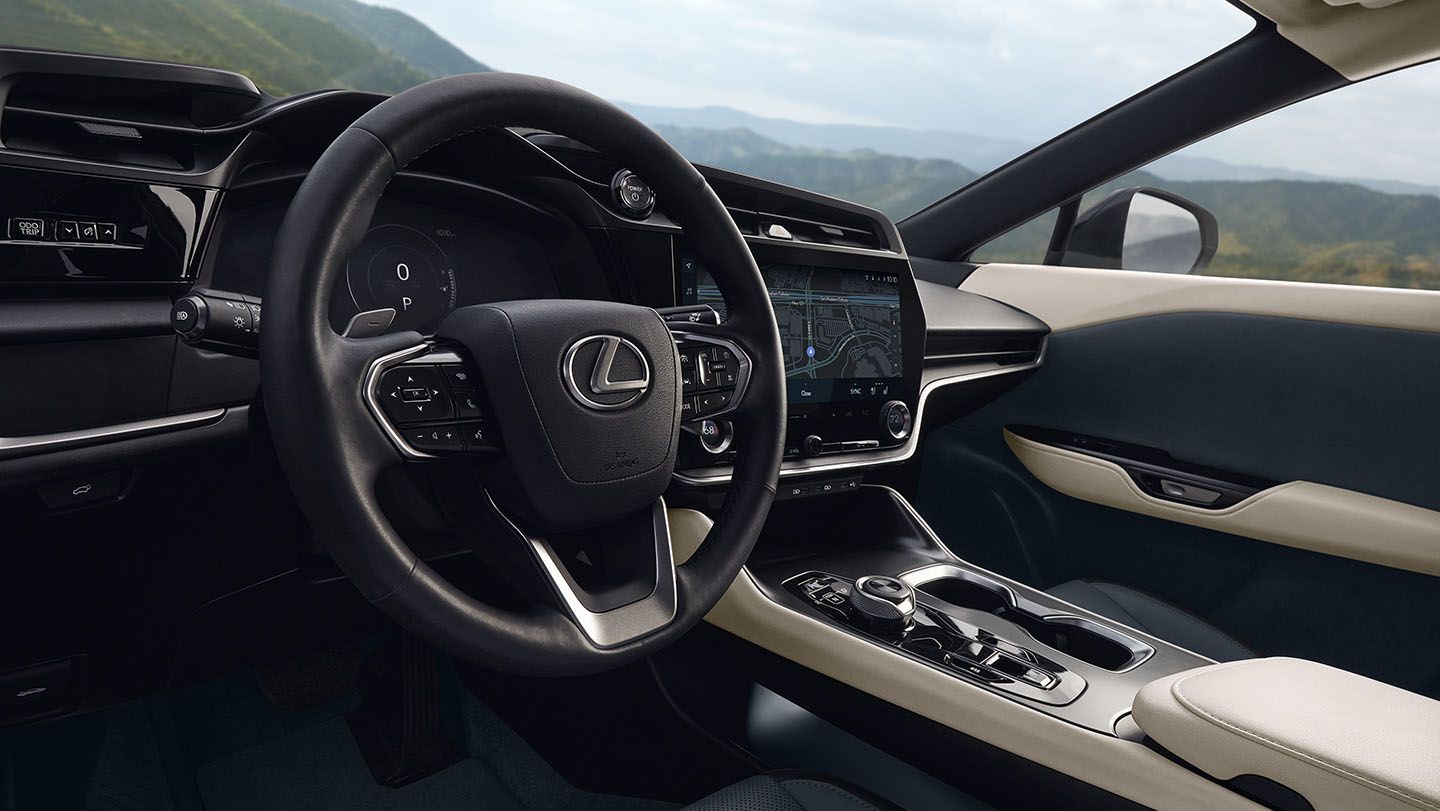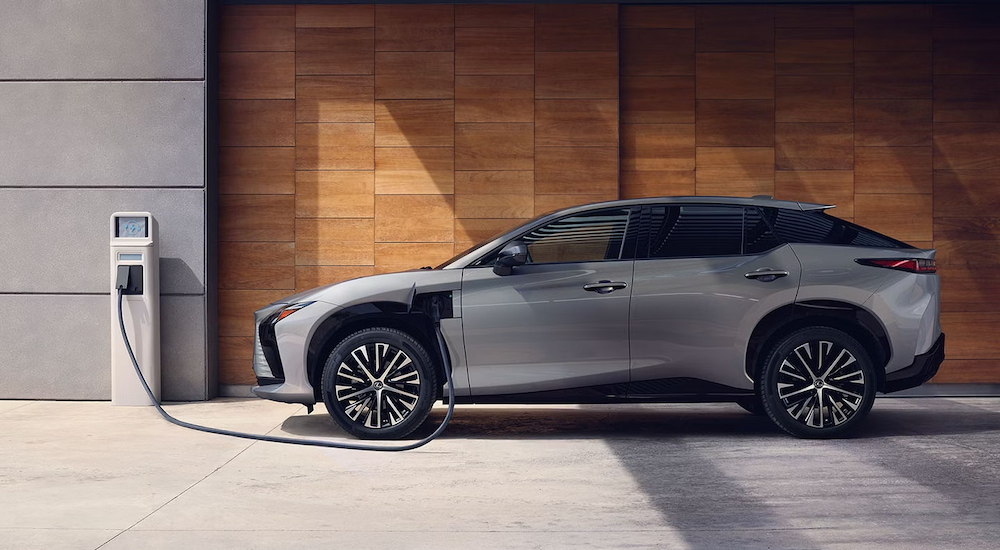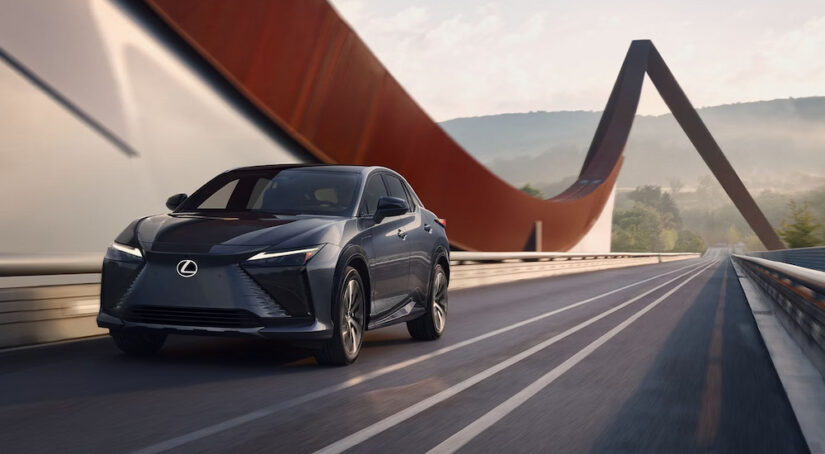Lexus might not have been the first luxury brand to break into the EV market, but it’s certainly making up for lost time with the introduction of the Lexus RZ. Debuting in 2023, the RZ is built on the same e-TNGA platform as the Toyota bZ4X and Subaru Solterra, though it’s a decidedly more luxurious build-out than Toyota and Subaru’s offerings. The crossover SUV’s bold exterior styling helps it stand out from Lexus’ hybrid and gas models, but it’s the RZ’s interior, performance, and comfort that really distinguish the EV.
The all-wheel drive 2023 RZ 450e model proved to be popular right out of the gate, helping Lexus to achieve a new overall sales record with a 132 percent improvement over 2022. Hybrid and EV offerings were a big part of that success, representing 47 percent of global sales and helping the brand chart a new roadmap for the future. Now Lexus is doubling down on the RZ, introducing an entirely new, more affordable front-wheel drive version dubbed the RZ 300e. The RZ certainly has a lot of competition in the ever-expanding luxury EV segment, so is it worth a trip to your local Lexus dealer? Read on for our review of the new 2024 RZ and see if Lexus can continue to build on its early success.
Electric Performance
Drivers might flock to Lexus for the brand’s luxury pedigree, but the RZ is here to prove that performance doesn’t have to take a backseat. The crossover’s all-electric design gives the RZ an impressive performance resume. This can largely be credited to the EV’s instant torque, which allows for some thrilling acceleration. The new RZ 300e relies on a single motor to deliver 201 hp, but those seeking the model’s sportiest guise should look into the RZ 450e, which puts out 308 hp. The trim’s all-wheel drive setup funnels power to every corner of the vehicle, allowing the RZ 450e to achieve a remarkable zero to 60 mph time of just 4.6 seconds.
When it comes to performance, the biggest trick up the RZ 450e’s sleeve would have to be Lexus’ DIRECT4 all-wheel drive system. This new technology first hit the market in 2023 as part of the Lexus RX Hybrid but has since been expanded to the RZ model with great success. The electric drive control system efficiently delivers torque across both axles, funneling 100 percent to the front or back wheels as needed. This is made possible thanks to the system’s set of high-output, high-torque e-axle units, which are basically electric motors connected to dedicated transaxles. The front e-axle puts out 150 kW while the rear delivers 80 kW, but it’s about more than pure power.
The e-axles allow the RZ 450e’s DIRECT4 system to improve both comfort and performance, thoughtfully distributing the EV’s energy to optimize traction and create a smooth ride that doesn’t lack in thrills. The DIRECT4 system not only enhances power and traction but also has a noticeable effect on posture control, managing the SUV’s pitch and dive for a more refined ride than you’d find in some other models. Lexus has designed the AWD model with a set of three-point eAxle motor mounts that, with their aluminum brackets and symmetrical positioning, allow the system to effectively counterbalance the RZ 450e’s considerable 320 lb-ft of torque.

Comfort and Driving Dynamics
The RZ’s e-TNGA platform is the EV’s secret weapon when it comes to comfort and driving dynamics. The platform, short for Electric-Toyota New Global Architecture, allows Lexus to address some of the biggest challenges associated with EV design. The lithium-ion battery pack used on EVs like the Lexus RZ might be able to pack a lot of power, but it also packs quite a few pounds. This weight can have a detrimental effect on a vehicle’s driving dynamics, but Lexus has engineered around this issue thanks in no small part to the e-TNGA platform, which allows the 96-cell lithium-ion battery to be mounted under the floor of the vehicle, lowering the RZ’s center of gravity to improve overall the SUV’s on-road behavior. The platform’s lightweight steel construction is a perfect complement for the RZ’s body, which maximizes weight-savings and rigidity with its aluminum hood and high-strength steel panels.
Of course, few components have quite as much of an effect on a vehicle’s driving dynamics as the suspension. Lexus has treated the RZ to a MacPherson strut suspension in the front and trailing arm multi-link setup in the rear. The rear suspension is matched with a set of Frequency Reactive Dampers, which can subtly adjust their damping force depending on the road conditions you’re facing. The MacPherson strut suspension boasts a compact, flexible design that soaks up bumps, potholes, and other common obstacles without adding any excess weight to the equation. The RZ’s suspension is notable for its balance and roll posture, which are all important factors in a luxury segment where comfort is a necessity, not an option.
Finally, there’s the RZ’s steering and braking systems. Lexus has packed the crossover with its new Active Hydraulic Booster-G (AHB-G) braking system, which goes a long way toward addressing a common complaint in the EV segment. The regenerative braking feature found in most of today’s EVs provides a clever and efficient way of slowing the vehicle by essentially flipping the electric motors in reverse, capturing kinetic energy, and converting it to electric energy that can be used to top off the battery while simultaneously bringing the vehicle to a stop. There’s only one problem: this isn’t always the smoothest or most natural-feeling experience for those accustomed to gas-powered vehicles. The AHB-G braking system solves this problem using a Vehicle Stability Control actuator and an on-demand pressurizing system to give the brake pedal a familiar feel. Independent pressure regulation helps to address front-to-rear brake force distribution and posture. The result is an EV that drives more like a traditional internal combustion model while delivering all the performance and efficiency benefits of the all-electric approach.
More Range
With their efficiency, lower operation and maintenance costs, and environmentally friendly nature, EVs offer some real advantages over typical internal combustion vehicles. That said, they also introduce an important new factor into the mix when it comes to comparing models: range. Concerns around all-electric driving range are often cited as one of the biggest hurdles to widespread ownership, proving just how vital this metric can be. So, how does the 2024 Lexus RZ stack up when it comes to range? It all depends on which trim you choose.
The Lexus RZ has been dinged for its sub-par range, but that fails to take into account some of the nuances of the EV crossover. Sure, the RZ 450e might lag behind the industry average with an estimated all-electric range of 220 miles (or 196 miles with the optional 20-inch wheels), but the new rear-wheel drive RZ 300e balances things out with a 266-mile range that’s much closer to par. Given that the average American drives around 300 miles per week, the RZ’s range should be more than adequate for all but the most wanderlust-afflicted drivers.
Being able to charge your vehicle at home is also an improvement over endless, expensive visits to the gas station––a fact that’s largely fallen by the wayside in the rush to criticize the RZ. With an EPA-estimated rating of 125 MPGe combined, the RZ is by far the most efficient model in the current Lexus lineup. The new front-wheel drive model is also a considerable bargain when compared to the RZ 450e, ringing in at almost $5,000 less and softening the blow when it comes to any range-related concerns.

A Luxury Interior
The Lexus RZ’s performance, comfort, styling, and range might check all the boxes for a luxury model, but those factors often take a backseat to the interior in the eyes of the segment’s typical buyer. Interior quality has long been a focus at Lexus, and a new generation of EVs allows the brand to do what it does best. The crossover’s cabin is bright and roomy, the latter of which can be credited to the EV’s minimal powertrain and low-slung e-TNGA platform. A panoramic glass roof lets in plenty of light, though if you’re looking to switch things up, it’s as easy as engaging the Dynamic Sky dimming function, which adjusts the opacity for a darker cabin.
The dashboard is defined by its premium suede and synthetic leather surfaces, as well as its conspicuous lack of buttons. Lexus has integrated many of the EV’s controls into the 14-inch infotainment display, though drivers seeking a more futuristic approach can also control many functions with voice commands, thanks to the Intelligent Assistant feature. Simply say, “Hey, Lexus,” and you’ll be able to manipulate navigation, climate controls, and multimedia features without ever taking your hands off the wheel. The generous display is just one of the RZ’s three available interfaces, with a digital gauge cluster and optional 10-inch heads-up display rounding out its arsenal.
The EV is also noticeably serene compared to many other models on the road, with Lexus employing everything from smaller A-pillars and a continuous hood seal to sound-damping glass, carpets, and foam, and even an Active Sound Control (ASC) system. ASC essentially filters out exterior noise, turning the RZ’s cabin into a tranquil little respite from the hustle and bustle of the outside world.
Lexus’ new EV comes with all the connectivity features one would expect from a modern luxury vehicle, including Bluetooth, Apple CarPlay, and Android Auto, allowing drivers to enjoy their favorite tunes from Apple Music and Amazon Music. Still, the way this music is delivered is one of the interior’s most notable highlights. The base trims come with a 10-speaker Lexus sound system, but upgrading to the fancier trims will open the door to a 1,800-watt, 13-speaker Mark Levinson Surround Sound system. Regarded as one of the premium stereo brands in the world of mobile audio, Mark Levinson delivers high-fidelity sound that elevates the listening experience when combined with the RZ’s virtually soundproof interior.
An EV That Was Worth the Wait
Lexus might not have rushed into the EV segment like some of its competitors, but the RZ was certainly worth the wait. The company has managed to embrace an entirely new type of automotive design without sacrificing those little quirks and features that have long made the brand such a popular choice in the luxury segment. The debut model was already one of the segment’s standouts, but Lexus has managed to improve on the formula with the introduction of the new front-wheel drive RZ 300e. The new model might lack some of the performance of RZ 450e, but the lower starting price should go a long way toward addressing accessibility for those who felt priced out of the market. The RZ has found a way to strike a balance between comfort and driving dynamics, a tricky maneuver that has stymied plenty of brands over the years. From its well-appointed interior and spirited performance to its polished styling and ultra-efficient electric powertrain, the 2024 RZ gives drivers a good reason to be excited about Lexus’ future EV offerings.



